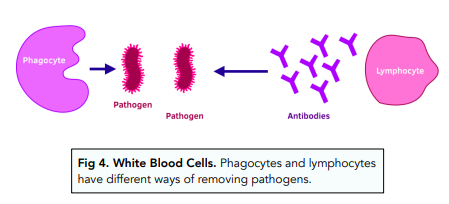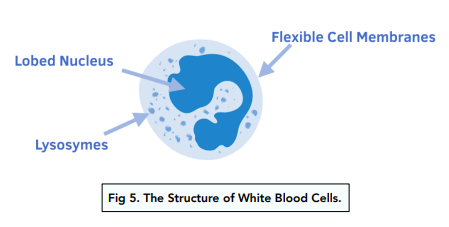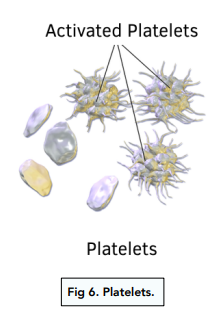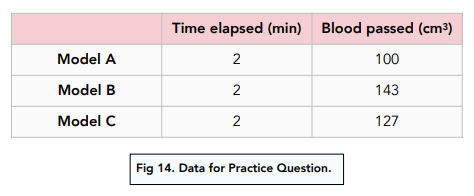Blood and Blood Vessels - White Blood Cells and Platelets (GCSE Biology)
Blood: White Blood Cells and Platelets
White Blood Cells (WBCs)
Function
- WBCs are the protective armies of the body, helping to protect against infection and foreign pathogens.
- Some WBCs (phagocytes) engulf and eat pathogens in a process called phagocytosis.
- Other WBCs (lymphocytes) produce antibodies or antitoxins to fight against pathogens.

Structure
- WBCs have flexible cell membranes, which can form extensions called pseudopodia, to help engulf foreign pathogens.
- WBCs also have many lysozyme enzymes in their cytoplasm, which are useful for breaking up and digesting foreign pathogens.
- Sometimes WBCs have a lobed nucleus (see diagram).

Platelets
Function
- Platelets are fragments of cells that are used to clot the blood. Without platelets, there would be excessive bleeding every time you cut yourself and had a wound. By clotting, platelets reduce blood flow around the wound. It also prevents pathogens from entering your wound.
- If you have too many platelets, then you are at risk of a blood clot (leading to things like stroke), but if you have too few platelets, you can bruise and bleed very easily.

Structure
- Like RBCs, platelets have no nucleus.
- Platelets are fragments (small parts of) cells which look very small in diagrams.
- Platelets have cell surface proteins, which enable them to clump together and close up a broken blood vessel.
- Platelets also have stored proteins, which they release to initiate a sequence of reactions called the clotting cascade. This causes something called fibrinogen to be converted to fibrin to form a mesh which causes the clotting of blood.
Rate of Blood Flow: Calculations
Rate of blood flow is the volume of blood passing a certain point per unit time. The equation is as follows:

Practice Question: Jesse is investigating 3 models, each representing an artery, vein and capillary. The results are shown in the table below. Work out the rate of blood flow (in cm³ per second) for each model. And then suggest which model is likely to be the artery.

- Make sure everything is in the correct unit form.
The question wants us to give the answer in cm3 per second. Blood passed is in the correct units, but we need to convert the time elapsed to 120 seconds. - Work out rate for each model.
Rate = volume of blood / number of minutes
A. Rate = 100 / 120 = 0.83 cm³ / second
B. Rate = 143 / 120 = 1.19 cm³ / second
C. Rate = 127 / 120 = 1.06 cm³ / second - Final answer
Arteries have blood travelling at the highest pressure and highest pace, therefore there blood flow will tend to be greatest in an artery. So we can confidently say that the artery model is likely to be Model B.
White blood cells, also known as leukocytes, are cells in the blood that help fight infections and diseases.
Platelets, also known as thrombocytes, play a crucial role in blood clotting. They help to prevent bleeding by clumping together at the site of an injury and forming a clot.
White blood cells help to fight infections and diseases by identifying and destroying harmful pathogens, while platelets help to prevent bleeding and protect the body from excessive blood loss. Both white blood cells and platelets are important for maintaining good health.
White blood cells are cells that help to fight infections and diseases, while platelets are cells that help to prevent bleeding by forming clots. White blood cells are larger than platelets and have a different function in the blood.
Blood vessels are tubes that carry blood throughout the body. There are three types of blood vessels: arteries, veins, and capillaries.
Blood vessels transport blood from the heart to the rest of the body and back to the heart again. The arteries carry oxygenated blood away from the heart, while the veins carry deoxygenated blood back to the heart. The capillaries are tiny vessels that connect the arteries and veins and allow for exchange of nutrients, oxygen, and waste products between the blood and the body’s cells.
The study of blood and blood vessels is important in biology because it helps us understand the body’s circulatory system and the role that blood cells and vessels play in maintaining good health. Understanding how the circulatory system works can also help us diagnose and treat diseases and disorders.






Still got a question? Leave a comment
Leave a comment